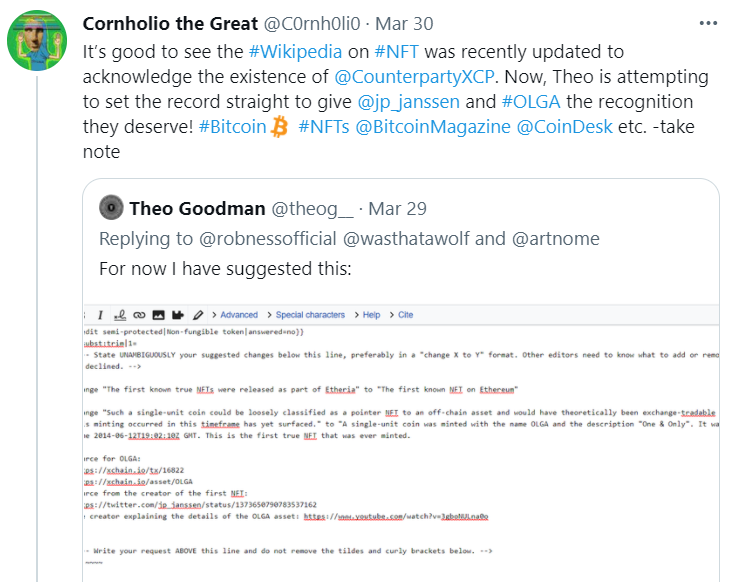Shortly after OLGA was discovered, this fact was added to the Wikipedia NFT article.

The exact text was; A single-unit coin was minted with the name OLGA and the description “One & Only”. It was minted at the following time 2014-06 12T19:19:02:107 GMT. This is the first true NFT ever minted.
Sources backing up the claim were also included.
Believe it or not, all references to OLGA are now removed and the article is locked from editing. Sadly someone with admin rights has hijacked the article. Why? Clearly to hide the facts and to promote their own disingenuous narrative.
Not only has OLGA been censored. All references to other Bitcoin NFTs are also removed.
The article mentions only four NFT standards; Ethereum, FLOW, a Bitcoin Cash implementation and Tezos.
The Bitcoin standard Counterparty (where OLGA is issued) is dishonestly dismissed twice. First:
“The first one-off NFT was created on May 3, 2014, by Kevin McCoy and Anil Dash […] standing in stark contrast to the multi-unit, fungible, metadata-less “colored coins” of other blockchains and Counterparty.“
McCoy’s pre-NFT experiment is not a valid NFT. I’ve explained why here and here. To add absurdity to the above claim, OLGA is the opposite of what is described. OLGA is a single-unit, non-fungible token with metadata. This is exactly what you want from a true NFT. Counterparty is a token standard, and I tweaked the parameters just right to mint the first ever NFT.
The second mention of Counterparty:
“In 2017, the Ethereum blockchain started to gain prominence over bitcoin based token platforms, due to Ethereum having a system for token creation and storage built right into its blockchain thus eliminating the need for third-party platforms like Counterparty“
Third-party is a negatively loaded term in this context. Counterparty is a protocol or a meta-layer on Bitcoin. This is in contrast to Ethereum where the transaction and contract logic are on one and the same level. There are advantages and disadvantages with either approach.
The truth is that since 2014 Counterparty has made possible tokenized art, NFTs included. Ethereum, Flow, Bitcoin Cash and Tezos have later joined the party – and this should be a good thing!
Categories: Uncategorized